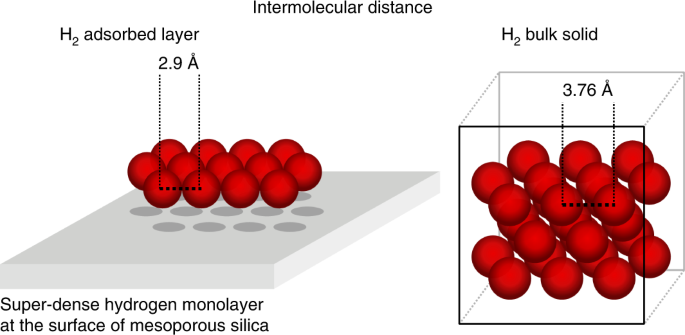The Max Planck Institute for Intelligent Systems led a team of scientists to demonstrate that hydrogen condenses on ordered mesoporous silica (KIT-6) at a temperature near the H2 boiling point (20.3 K, -423 F, or -252 C), forming a super-dense monolayer exceeding the density of liquid hydrogen by a factor of almost three. “Lowering the operating temperature of a cryo-adsorbent tank could yield a substantial increase in volumetric storage density, making it competitive with liquid-phase hydrogen storage,” the researchers wrote in “Formation of a super-dense hydrogen monolayer on mesoporous silica,” which was published in Nature Chemistry. The team from Technische Universität Dresden, Friedrich-Alexander-Universität Erlangen-Nürnberg, and the US Oak Ridge National Laboratory used high-resolution cryo-adsorption studies with characterization by inelastic neutron scattering vibration spectroscopy. The low temperature reduces the volume of 1 kg of hydrogen to only 5 liters. The scientists used mesoporous silica with smooth connected surfaces, as the super-dense hydrogen monolayer may not form on highly fragmented surfaces.
Delft University of Technology researchers have performed, for the first time, H2/water multiphase flow experiments at core scale under medical X-ray computed tomography (CT) scanner, in order to test hydrogen transport properties in porous rocks. “The interplay between gravitational, capillary and viscous forces can lead to complex displacement patterns during UHS [underground hydrogen storage] in reservoir rock. The high density contrast between the H2 and water phase can result in gravity segregation. Capillary barriers can counteract this effect, and enhance the spreading of hydrogen,” the researchers wrote in “Experimental characterization of H2/water multiphase flow in heterogeneous sandstone rock at the core scale relevant for underground hydrogen storage (UHS).” The paper, published in Scientific Reports, said that visualization of the saturation distribution is necessary to ensure the validity of relative permeability and capillary pressure measurements for the H2/water system. They said storing hydrogen is not like storing CH4 and CO2 for three reasons. The cyclic loading and frequency of injection will be determined by “the intermittent green energy production;” the purity of the gas stream reproduced from the reservoir will be more critical in the case of hydrogen due to problems stemming from hydrogen impurities; and hydrogen's low density and low viscosity could lead to complex interplay of gravitational, capillary and viscous forces.
Itochu and Air Liquide Japan have teamed up to construct a hydrogen refueling station for large commercial vehicles in Motomiya, in Japan's Fukushima prefecture. It is set to start operation in the first half of 2024. Itochu also signed a memorandum of understanding on green ammonia projects with Sasol. “The parties will jointly study the development of ammonia supply chain including green ammonia production facility which Sasol plans to develop in Boegoebaai, Northern Cape province, South Africa. The study will include an export-orientated project of green ammonia for power applications, bunker fuel, and other conventional applications,” said Itochu.
Jera and Uniper have agreed to procure and sell energy from the United States, to facilitate large-scale “clean ammonia production projects.” Japanese power producer Jera also announced plans to collaborate with ConocoPhillips on a proposed US hydrogen gas project on the US Gulf Coast.
Energinet and Gasunie Deutschland have signed a memorandum of understanding to accelerate preparations for cross-border hydrogen infrastructure between Denmark and Germany. The companies conducted a techno-economic pre-feasibility study showing that Denmark could potentially supply 10% to 25% of future German hydrogen demand.
Hyundai Motor has announced investments in three companies – Impact Coatings, H2Pro and GRZ Technologies – to strengthen its position in the hydrogen fuel cell ecosystem. Sweden's Impact Coatings is a supplier of PVD1-based coating solutions for fuel cells, and Israeli startup H2Pro developed E-TAC (electrochemical, thermally active chemical) water splitting technology. Switzerland's GRZ Technologies, meanwhile, specializes in hydrogen storage.
BAM has converted a diesel-powered, asphalt-spreading paver into a machine with a hydrogen combustion engine. “Often fuel cells are used to convert hydrogen into electricity. Instead, BAM and Van Twist have used a hydrogen combustion engine. Unlike a fuel cell, the quality of hydrogen is not important for a hydrogen combustion engine,” said the Dutch construction-services business.
Transport Enterprise Leasing has signed a letter of intent to purchase 15-liter hydrogen internal combustion engines from Cummins.
This content is protected by copyright and may not be reused. If you want to cooperate with us and would like to reuse some of our content, please contact: editors@pv-magazine.com.



By submitting this form you agree to pv magazine using your data for the purposes of publishing your comment.
Your personal data will only be disclosed or otherwise transmitted to third parties for the purposes of spam filtering or if this is necessary for technical maintenance of the website. Any other transfer to third parties will not take place unless this is justified on the basis of applicable data protection regulations or if pv magazine is legally obliged to do so.
You may revoke this consent at any time with effect for the future, in which case your personal data will be deleted immediately. Otherwise, your data will be deleted if pv magazine has processed your request or the purpose of data storage is fulfilled.
Further information on data privacy can be found in our Data Protection Policy.